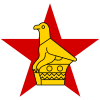This article needs to be updated. (August 2011) |
| History of Zimbabwe | ||||||||||||||||||||||||||||||||||||||||||
|---|---|---|---|---|---|---|---|---|---|---|---|---|---|---|---|---|---|---|---|---|---|---|---|---|---|---|---|---|---|---|---|---|---|---|---|---|---|---|---|---|---|---|
 | ||||||||||||||||||||||||||||||||||||||||||
Ancient history
|
||||||||||||||||||||||||||||||||||||||||||
White settlement pre-1923
|
||||||||||||||||||||||||||||||||||||||||||
Until roughly 2,000 years ago, what would become Zimbabwe was populated by ancestors of the San people. Bantu inhabitants of the region arrived and developed ceramic production in the area. A series of trading empires emerged, including the Kingdom of Mapungubwe and Kingdom of Zimbabwe. In the 1880s, the British South Africa Company began its activities in the region, leading to the colonial era in Southern Rhodesia.
In 1965, the colonial government declared itself independent as Rhodesia, but largely failed to secure international recognition and faced sustained internal opposition in the Rhodesian Bush War.
After fifteen years of war, following the Lancaster House Agreement of 1979 there was a transition to internationally recognised majority rule in 1980. The United Kingdom, which had never recognised Rhodesian independence, briefly imposed direct rule in order to grant independence on 18 April that year as the new country of Zimbabwe. In the 2000s Zimbabwe's economy began to deteriorate due to various factors, including the imposition of economic sanctions by Western countries led by the United Kingdom and widespread corruption in government. Economic instability caused many Zimbabweans to emigrate. Prior to its recognized independence as Zimbabwe in 1980, the nation had been known by several names: Rhodesia, Southern Rhodesia, and Zimbabwe Rhodesia.